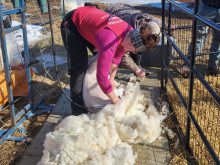RED DEER – Physiotherapy has a legitimate role to play in the overall health care of horses, says an American equine physiotherapist.
“Equine therapy follows a veterinarian’s diagnosis and I am against being separated from mainstream veterinary medicine,” Mimi Porter of Lexington, Kentucky, said at an Alberta horse breeders conference in Red Deer, held Jan. 12 – 14.
“We do our best work when we work with vets and there is less ignorance about each other’s fields.”
Porter has developed a curriculum on horse therapy used in Kentucky’s Midland College and worked with the 1996 equestrian Olympic team as a therapist.
Read Also

Charges laid after cattle theft
Saskatchewan RCMP lay two charges against a man after six cattle went missing.
Equine therapy includes massage, chiropractic, acupuncture, photon and ultrasound treatments for horses that have undergone surgery or are recovering from an injury.
Porter said equine therapists tend to view injuries on a holistic basis. They know that depression and fear are common among horses suffering pain. Once the pain is relieved, the horse’s attitude and appetite often quickly improve.
When equine therapists work on horses because of muscle soreness, they often discover that the situation is more than a little stiffness. Muscles can go into spasm and actually develop tiny cracks in the vertebrae that go undetected, she said.
“We believe it is never one joint or one muscle that is causing the problem. The whole horse is involved.”
Problems often start with the front feet, which are responsible for bearing 60 percent of the horse’s weight. Shoulders adapt to sore feet and the entire body structure can become unbalanced as muscles stiffen to compensate for pain. Joint pain eventually develops.
There are no overnight cures.
Besides deep relaxation massage and stretching exercises, Porter uses electrical stimulus, magnets, ultrasound therapy and photon therapy to bring relief to sore muscles and joints.
Photon treatment is a type of laser therapy that is non-invasive and appears to stimulate the circulation system and encourage tissue regrowth in foot and leg injuries.
Whether produced by a true laser or a photon device, a beam of light energy travels through tissue. Unlike ultrasound therapy, which heats specific tissues, photon therapy stimulates the release of neurotransmitters that activate cell functions without raising tissue temperature.
It has also been successfully used to lower pulmonary blood pressure, which is a stress failure of the capillaries in the lungs from overwork. It happens to racehorses, racing camels and greyhounds.
Equine therapists have also successfully treated laminitis, a painful foot condition.
Therapeutic ultrasound can treat damaged tendons. Sound waves vibrate and provide a massaging effect.
In simple treatments like cold therapy, therapists apply ice to reduce swelling and prevent hematomas.
In iontophoresis treatment, therapists use electrical currents to drive veterinary-prescribed drugs into trouble spots. It is non-invasive and sterile and the medication is concentrated locally.
Therapists use electrical stimulation to assess and treat nerve and muscle tissues. The treatment can increase circulation by causing blood vessels to dilate.
Therapists apply electrodes to the skin to deliver low-voltage, intermittent stimulation to surface nerves. The technique blocks the transmission of pain signals and releases endorphins, the body’s natural painkillers. Turning off the pain signal allows the body to heal.
Exercise programs are also developed for injured horses. They include balancing exercises and walking over poles and uphill.

















